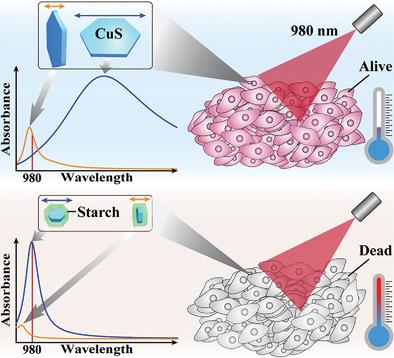Our official English website, www.x-mol.net, welcomes your
feedback! (Note: you will need to create a separate account there.)
Starch Capped Atomically Thin CuS Nanocrystals for Efficient Photothermal Therapy
Small ( IF 13.0 ) Pub Date : 2021-10-20 , DOI: 10.1002/smll.202103461 Zhiyong Zheng 1 , Ping Yu 2 , Huili Cao 1 , Mengyu Cheng 3, 4, 5 , Thomas Zhou 4, 5 , Li E Lee 2, 4, 5 , Jens Ulstrup 1 , Jingdong Zhang 1 , Christian Engelbrekt 1 , Lixin Ma 4, 5
Small ( IF 13.0 ) Pub Date : 2021-10-20 , DOI: 10.1002/smll.202103461 Zhiyong Zheng 1 , Ping Yu 2 , Huili Cao 1 , Mengyu Cheng 3, 4, 5 , Thomas Zhou 4, 5 , Li E Lee 2, 4, 5 , Jens Ulstrup 1 , Jingdong Zhang 1 , Christian Engelbrekt 1 , Lixin Ma 4, 5
Affiliation

|
Photothermal therapy requires efficient plasmonic nanomaterials with small size, good water dispersibility, and biocompatibility. This work reports a one-pot, 2-min synthesis strategy for ultrathin CuS nanocrystals (NCs) with precisely tunable size and localized surface plasmon resonance (LSPR), where a single-starch-layer coating leads to a high LSPR absorption at the near-IR wavelength 980 nm. The CuS NC diameter increases from 4.7 (1 nm height along [101]) to 28.6 nm (4.9 nm height along [001]) accompanied by LSPR redshift from 978 to 1200 nm, as the precursor ratio decreases from 1 to 0.125. Photothermal temperature increases by 38.6 °C in 50 mg L−1 CuS NC solution under laser illumination (980 nm, 1.44 W cm−2). Notably, 98.4% of human prostate cancer PC-3/Luc+ cells are killed by as little as 5 mg L−1 starch-coated CuS NCs with 3-min laser treatment, whereas CuS NCs without starch cause insignificant cell death. LSPR modeling discloses that the starch layer enhances the photothermal effect by significantly increasing the free carrier density and blue-shifting the LSPR toward 980 nm. This study not only presents a new type of photothermally highly efficient ultrathin CuS NCs, but also offers in-depth LSPR modeling investigations useful for other photothermal nanomaterial designs.
中文翻译:

用于高效光热治疗的淀粉覆盖的原子级薄 CuS 纳米晶体
光热疗法需要具有小尺寸、良好水分散性和生物相容性的高效等离子体纳米材料。这项工作报告了一种一锅、2 分钟的合成策略,用于具有精确可调尺寸和局域表面等离子体共振 (LSPR) 的超薄 CuS 纳米晶体 (NCs),其中单淀粉层涂层导致附近的高 LSPR 吸收-IR 波长 980 nm。CuS NC 直径从 4.7(沿 [101] 的高度为 1 nm)增加到 28.6 nm(沿 [001] 的高度为 4.9 nm),伴随着 LSPR 红移从 978 到 1200 nm,因为前驱体比率从 1 减少到 0.125。在50毫克的L光热温度升高了38.6℃下-1的CuS NC溶液激光照明下(980纳米,1.44W¯¯厘米-2)。值得注意的是,98.4% 的人前列腺癌 PC-3/Luc+ 细胞在3 分钟激光处理下被低至 5 mg L -1淀粉包被的 CuS NCs杀死,而没有淀粉的 CuS NCs 导致微不足道的细胞死亡。LSPR 模型表明淀粉层通过显着增加自由载流子密度和向 980 nm 蓝移 LSPR 来增强光热效应。这项研究不仅提出了一种新型的光热高效超薄 CuS NCs,而且还提供了对其他光热纳米材料设计有用的深入 LSPR 建模研究。
更新日期:2021-11-25
中文翻译:

用于高效光热治疗的淀粉覆盖的原子级薄 CuS 纳米晶体
光热疗法需要具有小尺寸、良好水分散性和生物相容性的高效等离子体纳米材料。这项工作报告了一种一锅、2 分钟的合成策略,用于具有精确可调尺寸和局域表面等离子体共振 (LSPR) 的超薄 CuS 纳米晶体 (NCs),其中单淀粉层涂层导致附近的高 LSPR 吸收-IR 波长 980 nm。CuS NC 直径从 4.7(沿 [101] 的高度为 1 nm)增加到 28.6 nm(沿 [001] 的高度为 4.9 nm),伴随着 LSPR 红移从 978 到 1200 nm,因为前驱体比率从 1 减少到 0.125。在50毫克的L光热温度升高了38.6℃下-1的CuS NC溶液激光照明下(980纳米,1.44W¯¯厘米-2)。值得注意的是,98.4% 的人前列腺癌 PC-3/Luc+ 细胞在3 分钟激光处理下被低至 5 mg L -1淀粉包被的 CuS NCs杀死,而没有淀粉的 CuS NCs 导致微不足道的细胞死亡。LSPR 模型表明淀粉层通过显着增加自由载流子密度和向 980 nm 蓝移 LSPR 来增强光热效应。这项研究不仅提出了一种新型的光热高效超薄 CuS NCs,而且还提供了对其他光热纳米材料设计有用的深入 LSPR 建模研究。











































 京公网安备 11010802027423号
京公网安备 11010802027423号